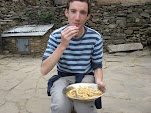I can't believe it's almost October again. Another academic year has started and this means not only another new intake of fresh meat for the university, but one year less of my PhD. Time doesn't half fly. According to my plan I made at the end of last year, I'd have built a system and be testing it now, and then after Christmas being saving the world. I have a feeling that might not happen now though.
As not much photo-worthy has happened over the last few weeks, I've included some of my favourite photos from the last year here, ones that I've not put in any blog posts before.
An advert for Tena Men I saw in a service station toilet, it made me chuckle a little...
I have to say the work I've been doing over the last few weeks hasn't been the most exciting in the world. I've been writing a paper on the Turgo testing I had done over the June and July. The paper's been quite difficult to get on with, as there have been several gaps I've needed to fill in. Well, not gaps as such, just bits that make the paper read better. At the moment it sounds a bit like a bad GCSE science report - I did this, then I did this, then I did this. A little bit disheartening, but with a bit more work I will hopefully getting it reading a lot better.
The inside of L'Arc de Triomphe, as seen during our trip to Paris last November.
Apart from writing a paper, I've spent a lot of time reading papers. In fact I'm in the process of sorting through over 60 papers that have different methods of droop control, that can be used to help connected inverters into parallel. The problem I've found is that there are a few different methods, with several people publishing papers on each different method. Some of them have slight tweaks which makes the method different, an extra term in the equation here or there, a slightly different mathematical relationship. But I'm not really sure how many different adaptions there are to each one. So the aim of the exercise is to identify as many different techniques as possible and record the salient points from each and then chose which ones to take forward into a model. This is going to take me a few more weeks, but I'm hoping it will be a worthwhile exercise. Fingers crossed!
Looking out to sea during our stay at the Lighthouse near Lynmouth with my church friends in January.
A birthday cake for Hannah's friend Lydia - I was quite proud of this one, as it was modelled on Lydia's cat Patch.
This month we also had our Harvest Messy Church. These are every quarter, and pretty much every time I cook, principally because it means I'm well away from kids then (slightly loose tongue + children = problem). I also actually really enjoy cooking, and rarely get a chance to cook for a large number of people. We normally cook for about 80 people, and this time we made a soup, packed full of British harvest vegetables. It was good fun, and I was surprised how many of the children actually enjoyed it. Some even came back for more. Who says children don't like good healthy food?
A white rhino we saw in Longleat Safari Park, during the joint birthday trip in March.
Today, I was invited back to Atkins, where I worked before starting my PhD. My friend there, Marie Adeyemi, was going to launch a program called Atkins Aerospace CARES, a corporate social responsibility initiative. Marie has done a fantastic job in convincing the management at Aerospace to allow this to go ahead, and even give the project a budget. They hope it will get Atkins people linking up with charities and NGOs, doing pro bono work and consultancy for them and encouraging a better team spirit in the company. Part of it is to encourage people to take sabbatical's, rather like me. I felt a bit awkward as I had left once I returned from my sabbatical year. However, it was great to see everyone there again. There were some faces I knew and some I didn't. It's strange how it sometimes feels you haven't left at all. Especially when the receptionist asked me if I had just forgotten my pass again (a rather usual occurrence for me!).
My eye, the wrinkles are really starting to show now…
Looking back, this year has been busy, and I've achieved a lot. I've presented at a conference, winning best paper in topic, I've built a small turbine and tested it, getting an amazing efficiency, I've travelled many thousands of miles including two trips to Nepal. However, time doesn't stop. I've got so much more to do in the next year, and if I don't get it done, then i'll be in real trouble. So, here's to the next year being productive, fun and memorable!
SAM

























































